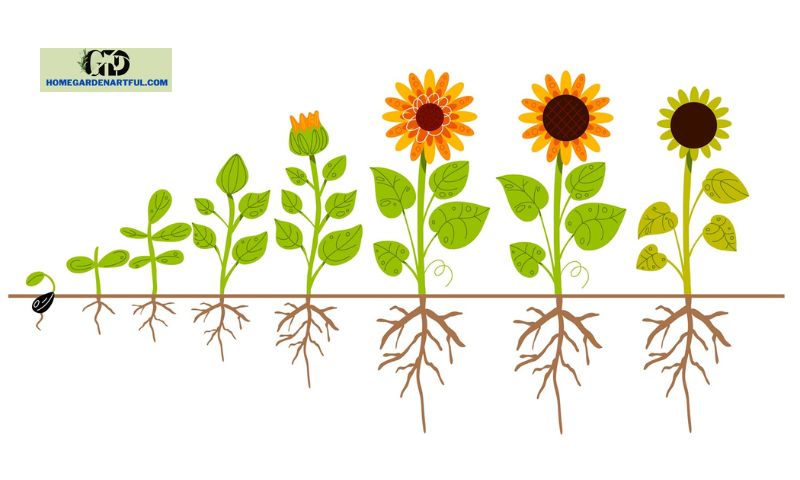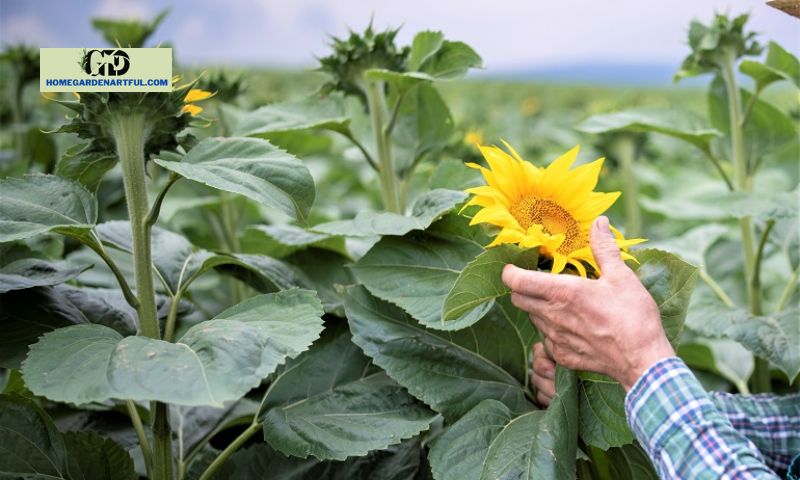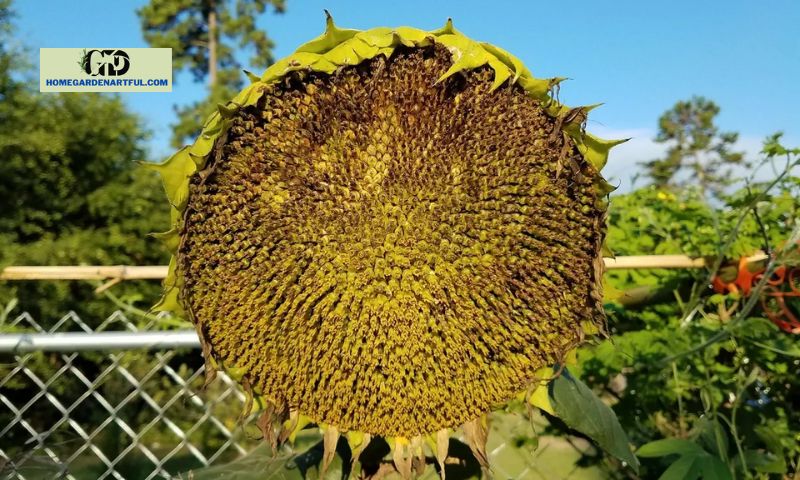How many are there in Sunflower Growth Stages? Sunflowers are not difficult to grow, but knowing how they grow will help you identify problems as they arise.
The seed, germination, vegetative growth, bud creation, blooming, and seed collection stages are crucial to the life cycle of a flower. At homegardenartful.com, discover all Sunflower Growth Stages for you in this article.
Sunflower Growth Stages

Seed
The seed stands for the plant’s latent, immature stage. The life cycle officially starts at this point.
The sunflower seed is a solitary dried-out fruit of a plant that still has its shell on. This complete seed contains all the genetic material and nutrients required to develop a new sunflower plant.
Given that the plant is a member of the Asteraceae family, which has two cotyledons in its seeds, its seed is a dicot.
Although the size of the seeds varies, they are typically about 7 mm long. In the soil, sow the seeds 1 to 1.5 inches deep.
Germination
The seed needs to be planted in the proper spot at the right time in order to germinate. Depending on the temperature and moisture levels, germination could take up to eight days.
The seed collects water and grows after a few days in the soil to the point in which the seed coat cracks. In search of sunlight, a developing sprout emerges from the wispy roots that have spread out.
Soon after that, the cotyledons will fall off and the first genuine leaves will show.
Vegetative Growth
Our sprout has grown into a tiny sunflower plant. It is trying to grow as much as it can at this point in its development.
A newly sprouting sunflower typically has two baby leaves, but as the stalk grows longer, many more appear. The first few sets of sunflower leaves are normally oval in shape, but as more sets develop, they take on a miniature version of the mature sunflower’s heart-shaped leaves.
Plants require their own energy to complete the floral life cycle stage of development. Photosynthesis is the name for this process. As soon as the leaves grow, the photosynthetic process begins.
The plant is anchored to the ground by its expanding root system, which also produces root hairs that aid in water and nutrient absorption.
The stem lengthens toward the sun and carries water and nutrients from the roots to the leaves. Starches and sugars are converted into the energy necessary for new plant growth.
Until floral structures begin to form, this period lasts 45 to 60 days.
Formation of Buds

After the vegetative growth stage, you will observe the development of a bud. Although the bud may appear star-like at first, by the conclusion of this stage, it will have transformed into a long-stemmed, yellow-blooming plant.
About 30 days pass during this stage.
Flowering
You’ll have around 20 days to savor the beauty of your sunflower after it has fully blossomed. In the blooming stage, bees may pollinate as well as fertilize the seeds.
Golden blossoms on your sunflower are most beautiful when they are in bloom. Make a bouquet with your flowers, place them in a vase, or create an autumn wreath.
Pollination
Sunflowers depend on pollinators to move pollen from one blossom to the next. Compared to other crops like corn, wind pollination is minor. The majority of sunflower pollen, which is thick and sticky, lands on the plant’s leaves during windy days.
Flowers self-pollinate by transferring pollen from the outside to the inside; after this, the seeds beneath turn from white to black. The blooms of a stressed plant typically do not pollinate fully.
Collection of seeds and drying
The sunflower plants are allowed to dry out in the field for up to 2 months after reaching physiological maturity.
It is more difficult to harvest sunflower seed heads before the plants have dried out. Reduced yield occurs as a result of seeds adhering to the fleshy portion of the seed head due to excessive wetness.
The life cycle might restart once the seeds have been collected and sown.
Drying and Seed Collection

The sunflower plants are allowed to dry out in the field for up to 2 months after reaching physiological maturity.
It is more difficult to harvest sunflower seed heads before the plants have dried out. Reduced yield occurs as a result of seeds adhering to the fleshy portion of the seed head due to excessive wetness.
The life cycle might restart once the seeds have been collected and sown.
Final Thoughts about Sunflower Growth Stages
These are recommended timetables for the many Sunflower Growth Stages; they vary depending on the variety.
Not all sunflowers are enormous plants; some are small, grow well in containers, and rarely reach higher than one foot.
Other kinds include those with solitary or branching stems, those with abundant pollen production, and those utilized in bouquets with little to no pollen production.
Sunflowers in general are a symbol of summer and an amazing, endless life cycle.


